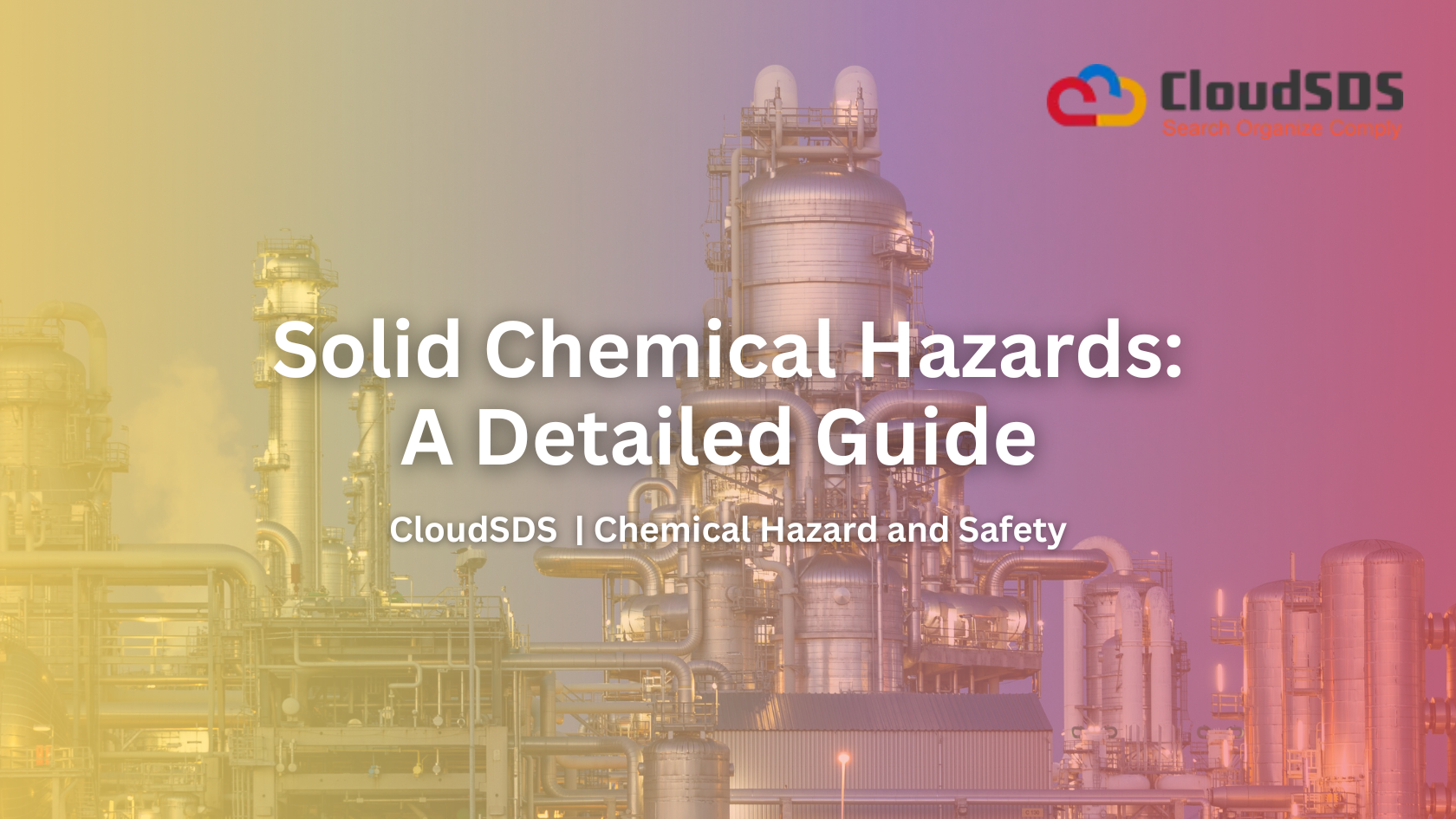Introduction
Solid-form chemicals are ubiquitous across laboratories, manufacturing, and industrial settings. Unlike liquids or gases, solids often generate dust or particulates that can disperse, be inhaled, or contaminate surfaces, compounding hazard potential. This guide explores classifications, hazard mechanisms, safe handling, storage, regulatory requirements, and training strategies to mitigate risks associated with solid chemical hazards.
Understanding Solid Chemical Hazards
Solid chemicals pose a wide array of physical and health hazards, from flammability and reactivity to acute and chronic toxicity. Comprehensive risk management requires understanding hazard classifications, consulting Safety Data Sheets (SDS), implementing engineering and administrative controls, and delivering targeted training through Learning Management Systems (LMS).
1. Hazard Classification of Solids
Under the Globally Harmonized System (GHS), solids exhibit both physical hazards and health hazards:
a. Physical Hazard Classes for Solids
- Flammable Solids (Category 1–2): Readily combustible powders or granules that ignite via friction, heat, or sparks.
- Pyrophoric Solids (Category 1): Ignite spontaneously in air.
- Self-Reactive Substances & Organic Peroxides (Types A–G): Thermally unstable solids prone to exothermic decomposition without oxygen.
- Oxidizing Solids (Category 1–3): Non-combustible but intensify combustion in other materials.
- Explosives: Unstable solids with potential for rapid decomposition and projection hazard.
b. Health Hazard Classes Relevant to Solids
- Acute Toxicity (Oral, Dermal, Inhalation Categories 1–4): Harmful or fatal if ingested, inhaled, or upon skin contact.
- Skin and Respiratory Sensitizers (Category 1): Can induce allergic reactions upon exposure.
- Carcinogenicity & Mutagenicity (Categories 1A–2): Potential to cause cancer or genetic defects.
- Specific Target Organ Toxicity (Single/Repeated Exposure Categories 1–2): Damage to organs like liver, kidneys, or lungs upon brief or prolonged exposure.
2. Mechanisms of Solid Hazards
- Dust Generation: Mechanical processes (grinding, cutting) liberate fine particulates, increasing inhalation risk and potential for dust explosions.
- Surface Contamination: Deposited dust can transfer to skin or surfaces, causing dermal exposure and cross-contamination.
- Reactivity with Moisture or Air: Water-reactive solids (e.g., metal hydrides) emit flammable gases or heat upon contact with water.
- Thermal Runaway: Self-heating solids can accumulate heat, leading to ignition in bulk storage.
3. Consulting Safety Data Sheets (SDS)
SDS are the primary resource for understanding specific hazards and controls for each solid chemical. Key sections include:
- Section 7—Handling and Storage: Lists incompatible materials, environmental controls, and hygienic practices.
- Section 8—Exposure Controls/PPE: Specifies Permissible Exposure Limits (PELs), engineering controls (e.g., local exhaust ventilation), and required personal protective equipment.
- Section 11—Toxicological Information: Details acute/chronic health effects, routes of exposure, and quantitative toxicity metrics like LD₅₀.
4. Safe Storage Practices
Effective storage minimizes accidental release, reactions, and decomposition:
a. Segregation by Hazard Class:
- Store flammables in approved flammable cabinets
- Keep oxidizers separate from organics and combustibles
- Isolate water-reactive solids from moisture sources
b. Environmental Controls:
- Maintain temperature and humidity within manufacturer-specified ranges
- Ensure well-ventilated, fire-resistant storage rooms
- Use secondary containment trays or bunds to capture leaks or spills
c. Labeling and Inventory Management:
- Apply legible labels with chemical identity, hazard pictograms, and dates
- Employ first-in, first-out inventory to prevent degradation of older solids
5. Safe Handling Guidelines
a. Engineering Controls:
- Local exhaust ventilation (e.g., fume hoods or dust collection systems) to capture particulates at the source
- Enclosed transfer systems for highly toxic or reactive solids
b. Administrative Controls:
- Develop standard operating procedures (SOPs) detailing handling steps, spill response, and waste disposal
- Limit quantities on benches to operational minimums to reduce exposure risk
c. Personal Protective Equipment (PPE):
- Respiratory protection (e.g., N95 or P100 respirators) for dusty operations
- Chemical-resistant gloves, lab coats, and safety goggles or face shields matched to chemical compatibility.
6. Emergency Preparedness
a. Spill Response:
- Use appropriate absorbents or neutralizing agents based on SDS guidance
- Have specialized spill kits for toxic dust and reactive solids
b. First Aid Measures:
- Flush skin or eyes immediately for corrosive solids
- In cases of inhalation, move the victim to fresh air and seek medical attention promptly
7. Regulatory Compliance
- OSHA Hazard Communication (1910.1200): Requires classification, labeling, SDS provision, and employee training on chemical hazards.
- Department of Transportation (DOT) Hazard Classes: Align transport packaging and labeling with DOT classes for flammables, oxidizers, and explosives.
- Local Regulations: Additional state or country-specific requirements (e.g., COSHH in the UK, WHMIS in Canada) must be integrated into facility protocols.
8. Training and LMS Integration
Leveraging an LMS enhances consistency and audit readiness:
- Course Authoring: Develop interactive modules covering GHS pictograms, hazard recognition, and SOPs for solid chemical handling.
- Assignments and Assessments: Automate competency evaluations with quizzes on SDS interpretation and emergency response.
- Reporting Dashboards: Track course completion, incident trends, and refresher training schedules to ensure continuous compliance.
9. Case Examples
- Arsenic Trioxide (Solid): A known carcinogen and acute toxin; requires glove box handling and HEPA-filtered ventilation to prevent inhalation exposure.
- Aluminum Powder: Flammable solid prone to dust explosions; store in airtight containers under inert atmosphere and avoid mechanical impact.
Conclusion
Solid chemical hazards demand rigorous hazard classification, meticulous storage and handling practices, and robust training programs. By integrating SDS guidance with engineering, administrative, and personal protective measures and leveraging LMS technology for training and documentation. For this, organizations can effectively mitigate risks and maintain regulatory compliance in environments handling solid chemicals.

Leave A Comment